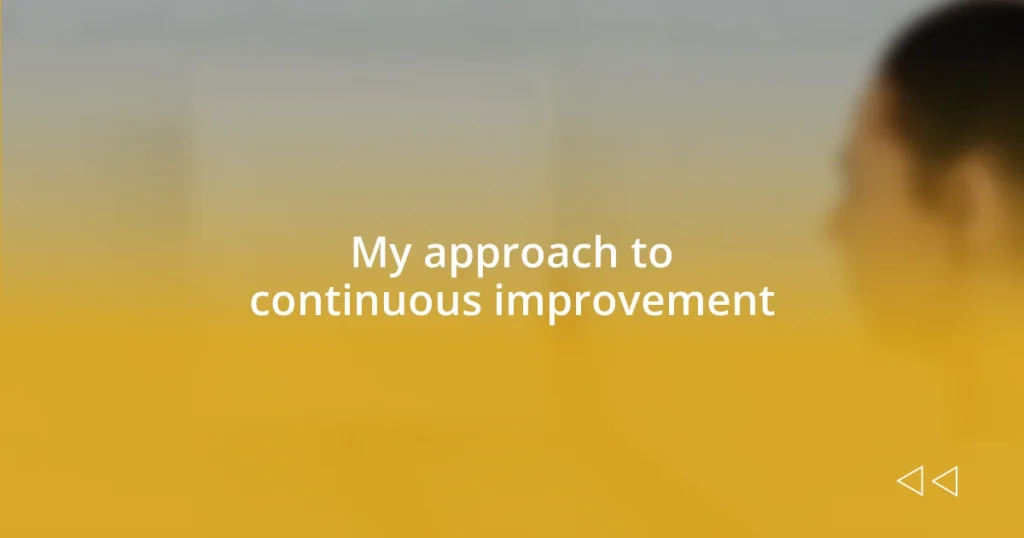Key takeaways:
- Continuous improvement is a mindset focused on ongoing refinement and fostering a culture of feedback and ownership among all team members.
- Key principles include incremental change, employee engagement, and using measurement and analysis to inform decision-making and drive improvements.
- Sustaining continuous improvement requires maintaining a culture of adaptability, ensuring all team members feel involved, and reconnecting with the core purpose of the initiatives.

Understanding continuous improvement
Continuous improvement is a mindset that encourages individuals and organizations to constantly refine their processes, products, and services. I remember when I first encountered this idea during a workshop; it felt like a light bulb moment. The thought of never settling for the status quo resonated deeply with me.
As I delved deeper into the concept, I realized that continuous improvement isn’t just about changes driven by metrics—it’s about fostering a culture where feedback is embraced. Have you ever noticed how small tweaks can lead to significant shifts in outcomes? For instance, in my own experience, adjusting a workflow slightly in my team resulted in not just enhanced efficiency but also sparked a sense of ownership and pride among my colleagues.
I often reflect on how the Japanese term “Kaizen” encapsulates this philosophy perfectly. It means “good change,” and it emphasizes that everyone, regardless of their position, can contribute ideas for improvement. I’ve seen this firsthand; when a junior team member suggested a simple change to our daily stand-up meetings, it transformed our communication and made everyone feel valued. Isn’t it fascinating how everyone has the potential to drive positive change?

Key principles of continuous improvement
Continuous improvement thrives on a few key principles that guide organizations in their journey. One fundamental aspect is the concept of incremental change. Rather than pursuing massive overhauls, I’ve learned that small, steady enhancements often lead to more sustainable results. For example, I once participated in a project where we introduced five-minute weekly reflection sessions. This simple addition allowed our team to address issues proactively, leading to noticeable improvements over time.
Engaging employees is another essential principle. It’s surprising how empowered individuals often yield the most insightful contributions to improvement efforts. I recall a time when I initiated a suggestion box in my workplace. The feedback was invaluable and made colleagues feel their voices mattered. When people believe they have a stake in the process, it strengthens their commitment to continuous improvement initiatives.
Lastly, measurement and analysis don’t just quantify change—they inform it. In one project, I utilized key performance indicators to track our progress. This wasn’t merely to evaluate our efforts but to understand where we could pivot and adapt. By closely analyzing our results, we identified areas for further enhancement, creating a feedback loop that engendered a culture of learning and growth.
| Principle | Description |
|---|---|
| Incremental Change | Focus on small, continual improvements rather than large-scale changes. |
| Employee Engagement | Encourage employees to contribute to improvement processes to enhance ownership and commitment. |
| Measurement & Analysis | Utilize data to inform decisions and drive further improvements based on performance indicators. |

Tools for continuous improvement
When it comes to tools for continuous improvement, I’ve found that a combination of methodologies can really drive success. Lean and Six Sigma, for instance, are quite powerful. Lean focuses on eliminating waste, while Six Sigma emphasizes reducing variation and errors. I remember when my team adopted these methodologies. Initially, it felt overwhelming, but as we broke down the processes, we unearthed fascinating insights that transformed our work.
Here are some practical tools that can enhance your continuous improvement efforts:
- 5S: A workplace organization method that stands for Sort, Set in order, Shine, Standardize, and Sustain.
- DMAIC: A data-driven improvement cycle used for optimizing and stabilizing business processes (Define, Measure, Analyze, Improve, Control).
- Pareto Analysis: A technique that identifies the most significant factors in a dataset, helping prioritize areas for improvement.
- Brainstorming Sessions: Collaborative meetings that encourage creative problem-solving and idea generation.
- Fishbone Diagram: Also known as an Ishikawa diagram, this visual tool helps identify potential causes of a problem, making it easier to address root issues.
Leveraging these tools can really empower teams to take ownership of improvement processes. I’ve seen how simple brainstorming sessions can ignite a spark of creativity and lead to solutions we hadn’t considered before. It’s amazing what a bit of structure can do to harness collective intelligence!

Implementing a continuous improvement strategy
Implementing a continuous improvement strategy requires a clear and well-communicated vision. From my experience, it’s vital to start by outlining specific goals and expectations for the team. For instance, when I led a project aimed at improving customer service, we organized a kickoff meeting to discuss our objectives and the role of each team member. This connection not only aligned everyone’s efforts but also infused a sense of ownership among the participants. Have you ever noticed how powerful it feels when everyone is on the same page?
Another critical element is creating a safe environment for experimentation. I remember a time when my team hesitated to share their ideas for fear of failing. By fostering a culture that values trial and error, we gradually built confidence in our ability to innovate. Implementing “fail-forward” sessions, where we openly discussed setbacks without judgment, allowed us to learn from each experience and move forward with enthusiasm. It’s remarkable how a little psychological safety can transform the way teams approach challenges.
Finally, celebrating successes—big or small—can have a profound impact on the continuous improvement journey. After a successful initiative, my team held a small gathering to acknowledge our collective efforts. This simple act of recognition not only boosted morale but also motivated us to aim for even greater improvements in the future. As I reflect on this, I often wonder: how do you celebrate the progress you make in your own projects?

Measuring continuous improvement success
Measuring the success of continuous improvement initiatives is something I take very seriously. One very effective way I’ve tracked progress is through key performance indicators (KPIs). I remember setting up a dashboard for a project that involved streamlining our production process. Each metric, from cycle time to defect rates, painted a vivid picture of how far we’d come. It’s like holding a mirror up to our efforts – you can see the changes more clearly.
Another approach I find invaluable is soliciting direct feedback from team members and stakeholders. During a recent initiative aimed at enhancing employee engagement, we distributed surveys to gather insights on their experiences. The open-ended responses were enlightening, revealing both triumphs and areas needing attention. Isn’t it interesting how sometimes the best measurements come from the very people involved in the process?
Lastly, I can’t emphasize enough the importance of regular reviews and reflections. Scheduling periodic check-ins with the team allows us to discuss what worked and what didn’t in a constructive manner. This practice reminds me of a time when we conducted a retrospective after a project launch. It was eye-opening to collaboratively pinpoint improvements based on both data and personal stories, transforming our future projects. How do you measure success in your initiatives?

Overcoming challenges in continuous improvement
Overcoming challenges in continuous improvement often hinges on addressing resistance to change. I recall a time when I introduced a new process in our workflow, and the team was initially hesitant to embrace it. Their concerns were valid; change can feel daunting. By facilitating open discussions where everyone could voice their apprehensions, we transformed that resistance into collective problem-solving. Isn’t it amazing how addressing fears directly can foster a sense of unity?
Another hurdle I’ve faced is maintaining the momentum of improvement initiatives over time. During a prolonged project, I noticed that enthusiasm began to wane. I initiated bi-weekly check-ins that weren’t just about data—these meetings were about sharing stories and recognizing small wins. Celebrating even the tiniest of improvements reinvigorated our team. How do you keep the fire of motivation alive in your projects?
Moreover, navigating the complexities of cross-departmental collaboration can pose its challenges. I once worked on an initiative requiring input from both operations and marketing. It took several brainstorming sessions to bridge gaps in understanding and align our objectives. This experience taught me the value of patience and active listening. Isn’t it fascinating how collaboration can reveal new perspectives and drive deeper engagement?

Sustaining continuous improvement efforts
Sustaining continuous improvement efforts demands not just dedication but an ongoing commitment to nurturing a culture of adaptability. I remember a challenging phase when our team was riding the wave of several successful initiatives, but I noticed the excitement beginning to fade. To combat this, I proposed the idea of ‘innovation days’ where we would step away from our regular tasks and brainstorm improvements—freedom to explore creativity often reignites enthusiasm. Have you ever found that the best ideas come when you’re least expecting them?
In my experience, one key aspect of sustaining these efforts is ensuring that everyone feels genuinely involved in the process. I once implemented a “suggestion box” initiative that allowed team members to submit their ideas anonymously. This not only sourced valuable insights but made everyone feel like stakeholders in our continuous improvement journey. It was heartwarming to see quieter team members shine through their suggestions. Isn’t it remarkable how inclusive practices can foster a sense of belonging and commitment?
To maintain the momentum, I find that reconnecting with the ‘why’ behind our efforts is crucial. During one project review, I led a session where we revisited our original goals and the impact our improvements had on the company’s mission. The ensuing discussions were filled with energy and passion, reminding us all why we started this journey. How frequently do we pause to recognize the significance of our work, and how does that recognition drive our efforts forward?















